
Animal Bite and Sting Wound Treatment Page Menu: 1 2 3 4 5 6 7 Next>>
Treating Animal Bites and Stings in the Golden Age of Piracy, Page 4
Non-Venomous Animal Wound Treatment
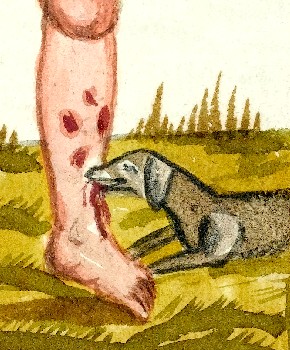
Dog Bite Wound, From
Arzneibuch, Wellcome (1675)
As explained at the beginning of this article, the focus in the surgical literature for curing victims of animal attacks was on venomous wounds. French surgeon Ambroise Paré is the only surgeon under study to even mention non-venomous wounds. He explains that such wounds "are less malign, which are of creatures wanting venom, as of Horses, Apes, Cats, Dogs not mad, and manie other things, which though of their own nature they are without poison"1. Even here, he cannot resist suggesting the specter of venom.
...yet in their bites is something more dolorifick [painful] and ill natured, then in common wounds inflicted by other occasions: I beleev, that in their slaver or sanies, there is something, I know not how to term it, contrarie to our nature, which imprint’s a malign qualitie in the ulcer, which also you may observ in the tearings and scratching of such creatures as have sharp claws, as Lions and Cats.2
Paré does not suggest a treatment for these types of wounds, however. The treatment of non-venomous animal wounds was apparently not regarded as distinct enough from other simple wounds to require an explanation of how they were to be treated outside of these comments by the French author..
1,2 Ambroise Paré, The Workes of that Famous Chirurgion Ambrose Parey, 1649, p. 509
Venomous Animal Wound Treatment
Photo: Wiki User Theasereje - Venemous Wolf Spider Ready to Attack
Venomous Wounds by animals were of the interest to surgeons writing during this period, probably because they had a unique facet: the poisonous substance which had been introduced to the body. All of the surgeons who discuss envenomed wounds give a generic treatment plan for them, regardless of which type of animal had caused the wound.
Some of the authors add to the generic explanation methods for treating wounds made by particular animals, only a few of which are relevant to the list of animals taken from the sailor's accounts and presented in the first half of this article. With this in mind, venemous bites by scorpions, snakes and stingrays will be discussed at the end of this article. In addition, attention was given to bee and wasp stings as well as spider bites. While these are not specifically mentioned in the sea accounts, such wounds were likely to have occurred without being considered notable enough to put into the manuscripts. So information on treating these types of wounds is included as well.
Venomous Animal Wound Treatment: Theory
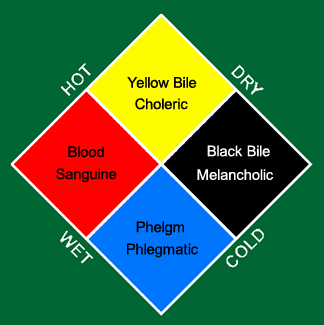
Humors, Temperaments and Elements
French surgeon Ambroise Paré discusses a bit of the theory behind venemous wounds much of which revolves around the idea that venom created heat. He explains that when "the poison bee sent into the bodie by a live creature, ...in such poison there is much heat; also there is therein a greater tenuitie [thinness], which serv’s as vehicles thereto into what place or part soever of the bodie they tend"1.
The concept of of heat used here is related to humor theory. According to Hippocrates, heat is one of four Elements which make up the body along with everything else in the natural world. The other three Elements are coldness, dryness and wetness. Each part of the body had its own particular balance of these Elements and that balance had to be maintained in order for the part to be healthy and properly functional.2 When venom created excess heat in the body, it caused problems according to this theory.
Another aspect related to humor theory which entered into this theory was Temperament. People were divided into categories or Temperaments based on their nature, which was impacted by the idea that heat as an Element in the makeup of the body. Paré explains this in some detail.
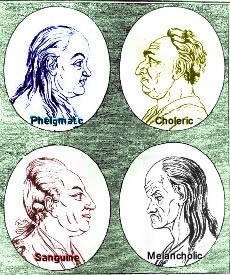
Artist: J. C. Lavaters
The Four Temperaments, From
Physiognomische Fagmente (1792)
For hot men that have larger and more open veins and arteries, yield the poison freer passage to the heart. Therefore they which have more cold and straight vessels, are longer ere they die of the like poison; such as are full, are not so soon harmed as those that are fasting: for meats, besides that by filling the vessels, they give not the poison so free passage, they also strengthen the heart by the multiplication of spirits, so that it more powerfully resist’s pernicious venom.3
The concept of Temperaments incorporates both the humors and the Elements along with other facets of a person. Each type was felt to have an excess of a certain humor and to display an abundance of those two Elements in their personality. Phlegmatic people had an excess of the humor phlegm and were cold and moist. Choleric people had an excess of yellow bile and were hot and dry. Sanguine people had an excess of blood and were hot and moist. And Melancholic people had an excess of the humor black bile and were cold and dry. In Paré's example, sanguine and choleric people would have been particularly susceptible to poisons because heat was one of the Elements they had in excess.
Heat was not the only factor affecting the speed with which a victim was poisoned; Paré also acknowledged the role of the type of venom. He noted that some venoms would kill "in the space of an hour" while others worked over the course of a couple days. The slower working poisons included several animals discussed in the previous section including "water-Snakes, a Spider, and Scorpion"4.
1 Ambroise Paré, The Workes of that Famous Chirurgion Ambrose Parey, 1649, p.510; 2 Paré, 5; 3,4 Paré, 510
Venomous Animal Wound Treatment: Cure
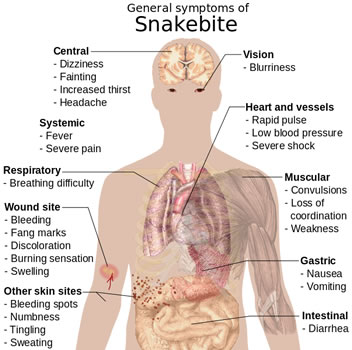
The cure of venomous Wounds sometimes began with recognizing the symptoms. Surgeon James Cooke lists a variety of symptoms that can accompany them, including: "Vehement Pain, livid Colour, [the wound] suddenly becoming black, Symptoms more grievous than the quality of the Wound calls for; Heat over the whole Body, Trembling, Delirium, Fainting." He further warns that even small wounds can kill a patient, "especially if [it is] near the Heart or any noble parts [the viscera], or if late before the Cure be undertaken"2. Today there are an even wider variety of symptoms associated with venomous wounds, such as are shown in the list of symptoms that can be found in snake bites in the chart at left.
Rapidly stopping the effect of the poison was a crucial step when treating venemous wounds. Ambroise Paré explained that in such wounds the goal was to evacuate the 'virulent and venenate humor' created by the venom, linking this problem to humor theory. (Since the body and its health was thought to be controlled by fluid humors, it makes sense that a poisonous fluid introduced by an animal bite would have an impact those humors.) Paré further advised, "Cure must speedily bee used without anie delaie to the bites and stingings of venemous beasts, which may by all means dispers the poison, and keep it from entering into the bodie"3.
Paré divided the removal of this unwanted humor into two types: "universal, which is [performed] by the inner parts [of the body]; and particular;

Author Ambroise Paré
by such to pick medicines as are fit to draw out, and retund [weaken] the venom"4. The body's 'universal' role in expelling the unwanted humor could be aided by some of the mechanical processes that were typically used when treating problems of the body's humors as well as a couple which were unique to venemous wounds.
The "particular" role of the body was accomplished using medicines as Paré suggested. Sea surgeon John Woodall recommended a variety of medicinals, advising that the most important step in these wounds is "taking away that which is virulent, [by] extracting, dissipating and consuming the poyson, which work requireth internall as well as externall medicaments."5 Paré adds that "each poison hath his peculiar antidote" without specifically listing them. However, he also agrees that the general medicines, such as those used in the treatment of mad dog attacks, would usually work just as well in other venemous wound cases.6
Once the poison was dealt with, the wound was to be healed. Physician Stephen Bradwell wrote that once the venom was removed, "If the wound be big, it must be healed up with some good Balsam as a greene [new] wound. But if it be but a pricke, it will soone heale it selfe, so it be but kept from the ayre."7 As Bradwell hints, there really wasn't anything special about healing an venemous wound once the venom had been dealt with. Healing such a wound was part of the realms of the ordinary and was to be healed using standard incised wound procedures.
1 James Cooke, Mellificium Chirurgiæ: Or, The Marrow of Chiururgery, 1693, p. 110; 2,3,4 Ambroise Paré, The Workes of that Famous Chirurgion Ambrose Parey, 1649, p.510; 5 John Woodall, the surgions mate, 1617, p. 131; 6 Paré, p. 515; 7 Stephen Bradwell, Helps For Suddain Accidents Endangering Life, 1633, p.45
Venomous Animal Wound Treatment: Mechanical Poison Removal
A variety of mechanical processes were suggested to help extract the poison which entered into the body through venemous wounds made by animals.
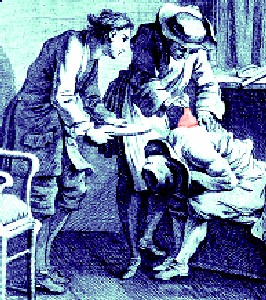
Artist: Jean-Baptiste Dudry
Cupping Ragotin to Reduce Swelling (early 18th c.)
James Cooke suggested that the cure of venomous wounds "consists chiefly in drawing out the Venom, by Cups [cupping], with, and without Scarific[ation]."1. German surgeon Matthias Gottfried Purmann recommends that the wound be washed and allowed to dry, after which the surgeon was to "scarify the part about the bigness of a half Crown piece, and apply to it a large Ventosa or Cupping Glass."2 Ambroise Paré states, "It is most convenient, if the part affected will permit, to applie large cupping-glasses with much flame and horns"3. 'Horns' refer to animal horns, such as those of cattle, which were sometimes used as cuppling glasses. The purpose of cupping and scarifying would be to draw the poison out of the wound. Cupping created a vacuum when placed on the wound and drew against the incisions made by scarification. (For more on how this worked, see the articles linked to in this paragraph.)
A couple surgeons suggested using blistering, which involved applying an irritant that raised blisters near the wound. Purmann explained that some surgeons used Vesicatories or medicines to cause blistering without specifically recommending it himself.4 French surgical instructor Pierre Dionis noted that "Blistering is an excellent Remedy against the Bitings of venomous Beasts"5, although he did not provide any further information. Here, the irritant was believed to draw the poison from the wound site into the blisters so that it could not damage the body.
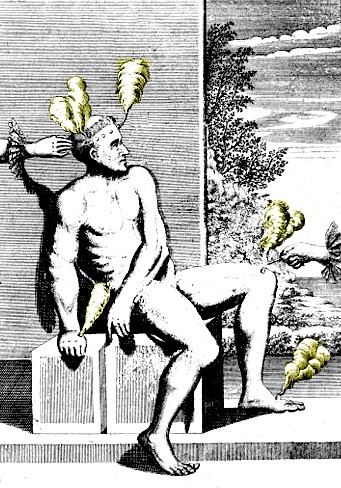
Artist: Michael Bernhard Valentini
Using Moxa as a Potential Cautery (1714)
The most recommended mechanical procedure was cauterization. There are two types of cautery - potential cautery - burning the skin through the application of chemicals - and actual cautery - the application of heated metal directly to the skin to burn it. Only one author under study mentions the use of a potential cautery for venemous wounds. Matthias Gottfried Purmann noted that the surgeon could use moxa, "which they burn to Ashes upon the part". The surgeon would then incise the scab created with a lancet and apply a compound medicine he calls Spiritus Matricalis to it. This compound medicine contains frankincense, myrrh, amber and rectified spirit of wine.6
The majority of surgeons advised actual cauterization using hot irons for envenomed wounds. Cooke reported that the method for removing poison "which is best, [is] by actual Cautery, but not in Nervous parts."7 Ambroise Paré explained, "nothing is so forcible to dispers and retund [weaken] the venom, as the impression of cauteries [on the skin], especially actual, for a hot iron works more effectually and speedily, and causseth an ulcer which will remain open a longer time."8 The longer the wound stayed open, the more time it had to eject the poison. An eschar or scab would then grow over the burn wound which the surgeons either scarified by making several incisions in it, or removed to allow the poison an easier escape. Since this procedure is covered in some detail in the surgical texts, it will be explained in its own section.
Two other mechanical operations for removing poison from a wound were also suggested in the surgical books from this time. These included sucking the poison out of the wound and using a perceived natural ability of certain animals to draw it out. Like actual cauterization, each of these are described in some detail, so they are discussed in their own sections.
Sea surgeon John Woodall recommended a couple of humor-based treatments not
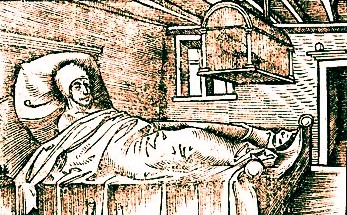
Sweating a patient (Ulrich von Hutton) in Bed (16th c.)
suggested normally in such cases. He advised the surgeon "thou mayst safely purge [via emetics and/or enemas], bathe & sweat"9. However, he warned that these methods were to be used only to purge poisons from venemous wounds where the 'noble parts' [the organs] had been 'offended,' "which is knowen when the animall faculties are offended."10
Outside of these special cases, such methods were not to be used; several surgeons specifically recommended against most standard humor-focused mechanical cures. Woodall himself specifically ordered his reader to "abstaine from bleeding, unlesse the noble parts bee tainted"11. James Cooke warned that when treating venemous wounds, "Purging [using emetics to cause vomiting, diuretics or laxatives] , V.S. [venesection or bleeding] and Clysters [enemas] hurt"12.
Paré gives the most satisfying detail about the humoral procedures which should not be used, when they should not be used and why.
[Y]ou must observ this rule, that you let no blood, give no purgeing medicine [diuretic or laxative], nor glister [clyster or enema], nor vomit, nor much use no bath, nor other thing that may procure sweat, until three daies bee past after the bite or sting. In the mean space let the patient from all manner of labor, but chiefly venerie [sex], lest by causing an agitation of the humors, the poison get sooner to the heart. Therefore then it is time to use universal evacuations, when as you shall suspect that the poison is diffused over the veins and whole inner part of the bodie besides.13
1 James Cooke, Mellificium Chirurgiæ: Or, The Marrow of Chiururgery, 1693, p. 111; 2 Matthias Gottfried Purmann, Churgia Curiosa, 1706, p. 186-7; 3 Ambroise Paré, The Workes of that Famous Chirurgion Ambrose Parey, 1649, p.511; 4 Purmann, p. 187; 5 Pierre Dionis, A course of chirurgical operations: demonstrated in the royal garden at Paris. 2nd ed., 1733, p. 477; 6 Purmann, p. 187; 7 Cooke, p. 111; 8 Paré, p. 511; 9.10,11 John Woodall, the surgions mate, 1617, p. 132; 12 Cooke, p. 111; 13 Paré, p. 511

